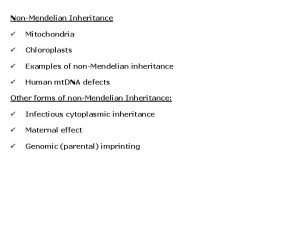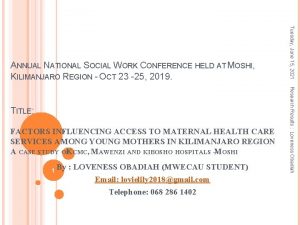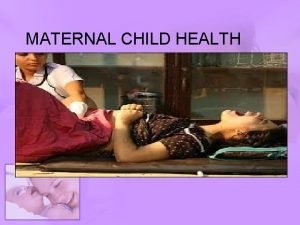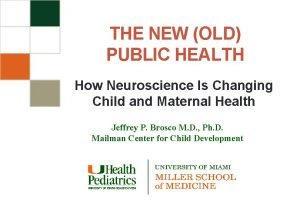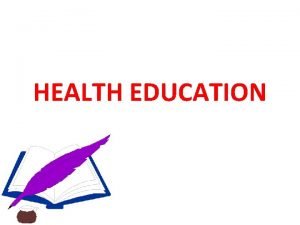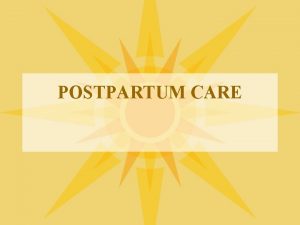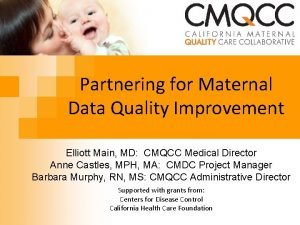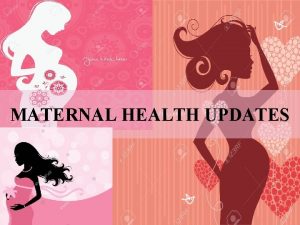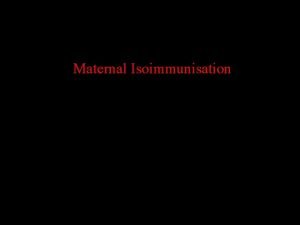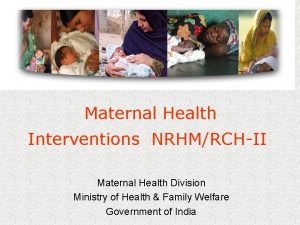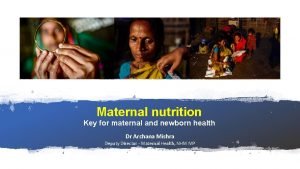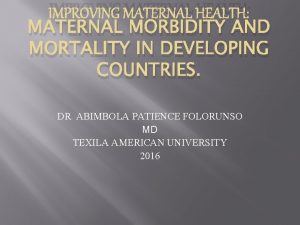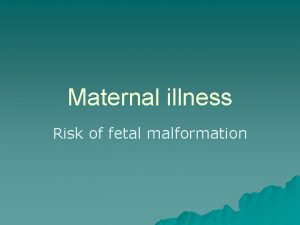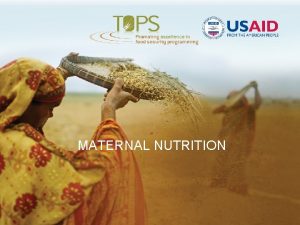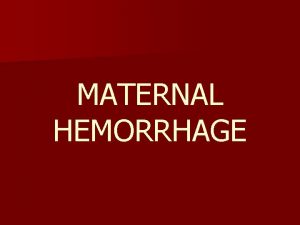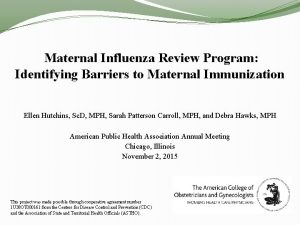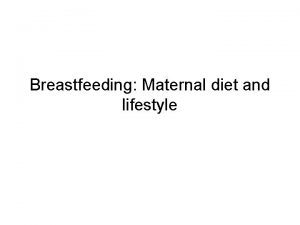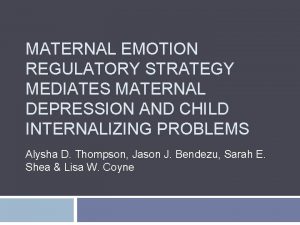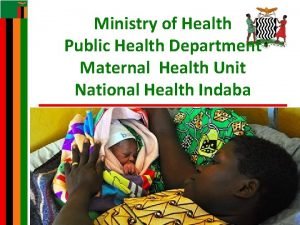Maternal Health Definitions Maternal health refers to the
























































- Slides: 56

Maternal Health

Definitions ▪ Maternal health: refers to the health of women during pregnancy, childbirth and the postpartum period. ▪ Health indicators: a measurable characteristic that describes the health of a population (e. g. , life expectancy, mortality, disease incidence or prevalence, or other health states)

Facts: Fact 1 Nearly 830 women die every day due to complications during pregnancy and childbirth. Fact 2 Women die in pregnancy and childbirth for 5 main reasons


Facts: Fact 3 More than 135 million women give birth per year About 20 million of them are estimated to experience pregnancy-related illness after childbirth. The list of morbidities is long and diverse, and includes fever, anaemia, fistula, incontinence, infertility and depression. Women who suffer from fistula are often stigmatized and ostracized by their husbands, families and communities. Fact 4 About 16 million girls aged between 15 and 19 give birth each year They account for more than 10% of all births. In the developing world, about 90% of the births to adolescents occur in marriage. In low- and middle-income countries, complications from pregnancy and childbirth are the leading cause of death among girls 15 -19.

Facts: Fact 5 Maternal health mirrors the gap between the rich and the poor Fact 6 Most maternal deaths can be prevented


Facts: Fact 7 Many women don’t see a skilled health professional enough during pregnancy Although a large proportion of women see skilled health personnel at least once during their pregnancy, only about half receive the recommended minimum of at least 4 visits during the pregnancy. Women who do not receive the necessary check-upsmiss the opportunity to detect problems and receive appropriate care and treatment. This also includes immunizationand preventionof mother-to-child transmission of HIV/AIDS. Fact 8 About 22 million abortions continue to be performed unsafely each year Over 5 million of these result in complications some of which may end in death. Almost every one of these deaths and complications could have been prevented through sexuality education , contraceptive use , and the provision of safe, legal induced abortion, and care for complications of unsafe abortions.

DEFINITION: variables that reflect the state of health of persons in a community. ddddd Health Systems Indicators

Health indicators could be used to: Assess the health care needs. • Compare health status of different areas or groups of people over time, one country with other countries or worldwide. • Monitoring and evaluation of health services, activities and programsaccess, quality, effectiveness and equality. • dddff Health Systems Indicators (Maternal)

Maternal health indicators:

Health Systems Indicators (Maternal)

Proportion Maternal Death: Proportion of all female deaths due to maternal causes = (N of maternal deaths in a period/Number of all female deaths in same period) * 100 Health Systems Indicators (Maternal)


Health Systems Indicators (Maternal)

Health Systems Indicators (Infant)

Perinatal Mortality rate: Deaths between 28 th week of gestation to less than 7 days of life expressed as per 1000 of total births (live and still) Reflects maternal health status, quality of maternal care and obstetric services Neonatal Mortality rate: Deaths in the first 28 days of life expressed as per 1000 of total live births. Reflects primarily quality of obstetric care and neonatal care as well as maternal nutrition and health status

Post neonatal Mortality rate: Deaths between 28 days of life to less than 1 year expressed as per 1000 of total live births. Reflects infants' health care, nutrition and sanitation of the environment Under-5 Mortality: Deaths below 5 years expressed as per 1000 of the number of children below the age of 5 years.

A. Maternal mortality ratio 1. Deaths between 28 week of gestation B. Maternal mortality rate 2. Deaths in the first 28 days of life C. Perinatal mortality rate 3. Number of maternal deaths in a D. Neonatal mortality rate 4. Deaths between 28 days of life to < 1 E. Postnatal mortality rate 5. Number of maternal deaths per live to less than 7 days of life expressed as per 1000 of total births. expressed as per 1000 of total live births given period per population of women who are reproductive age year expressed as per 1000 of total live births

A. Maternal mortality ratio 1. Deaths between 28 week of gestation B. Maternal mortality rate 2. Deaths in the first 28 days of life C. Perinatal mortality rate 3. Number of maternal deaths in a D. Neonatal mortality rate 4. Deaths between 28 days of life to < 1 E. Postnatal mortality rate 5. Number of maternal deaths per live to less than 7 days of life expressed as per 1000 of total births. expressed as per 1000 of total live births given period per population of women who are reproductive age year expressed as per 1000 of total live births

Trends in maternal mortality 1990 - 2015 Maternal mortality fell by almost half between 1990 and 2015 Maternal mortality ratio (maternal deaths per 100, 000 live births in women aged 15 to 49), by region, 1990, 2010 and 2015 Ref:

Health Systems Indicators (Infant)

Why has the maternal mortality declined?


Global response ▪ Sustainable Development Goal 3 ▪ 3. 1 By 2030, reduce the global maternal mortality ratio to less than 70 per 100 000 live births.

Successful Interventions for Maternal Care Antenatal care ▪ Nutrition support (anemia) ▪ Personal hygiene, dental care, rest and sleep ▪ Immunization (mother and the new born) ▪ Education on delivery and care of the new born ▪ Identifying high risk pregnancies ▪ Emphasizing on ANC visits and maintenance of AN card ▪ Importance and management of lactation ▪ Advise on birth spacing Ref: WHO recommendations on maternal health, guidelines to improve maternal health. 2017.

Factors Affecting Pregnancy and Childbirth Maternal health and fetal development • Maternal nutrition • Smoking • Drinking • Diseases • Drugs • Maternal age • Prenatal care Pregnancy and childbirth • Preconception • health status • Age • Access to appropriate preconception • interconception health care • Poverty

Stages of maternal care Preconception Antenatal Care Postpartum

1. Preconception: Preconception health care : Is the medical care of a woman or man receives from the doctor or other health professionals that aimed to increase the chance of having a healthy baby.

1. Preconception: What is involved in preconception counseling? Questionnaire, Blood work, Urinalysis. . etc A)Maternal behaviors like : Tobacco use , alcohol use , failure to consume adequate folic acid. B)Other conditions like : unintended pregnancy , experiencing physical abuse , experiencing high levels of stress. C)Certain maternal health conditions like : Diabetes , hypertension , obesity

2. Age: �The chances of surviving the first year of life were better for infants born to mothers aged 20 -34 years than for those born to mothers of other ages. �The most favorable survival rates were among first births to mothers aged 20 -24 and among first and second births to mothers aged 25 -29.

Age under 20 �Women under the age of 20 have a significantly higher risk of serious medical complications related to pregnancy than those over 20. Teenage mothers are more likely to: 1. deliver prematurely 2. have a baby with low birth weight 3. experience pregnancy-induced hypertension 4. Nutritional deficiencies.

Age over 35 �The chances of conceiving begin to decline. An older woman who becomes pregnant is also less likely to have a problem-free pregnancy. �Common issues include the following: 1. Underlying conditions( DM, HTN) 2. Chromosomal problems 3. Miscarriage

3. Antenatal Care: Is the care you receive from healthcare professionals during your pregnancy. 1 - folic acid and vitamin D supplements 2 - nutrition, diet and food hygiene 3 - lifestyle factors : smoking, recreational drug use and drinking alcohol 4 - Antenatal screening tests

4. Interconception Health Care: Interconceptional health care: interconception health involves helping a woman understand the importance of being healthy between pregnancies and the need to wait at least 18 months before becoming pregnant again to help optimize birth outcome.

5. Poverty: • The findings in analysis of NMIHS indicate that, for infants born to women living in poverty in the United States in 1988, overall excess mortality risk was approximately 60% compared with infants born to women living above the poverty level. • hose living in poverty were more likely to smoke, to have poorer dietary habits, lower levels of education, and engage in higher risk and health-demoting practices.

2016 WHO ANC model

Risk Factor in maternal health 1. 2. 3. Hypertension 4. 5. 6. 7. 8. 9. HTN Heart Disease GDM Tobacco & alcohol use STDs Nutrition Unhealthy weight Genetic factor Postpartum depression

Unhealthy weight Is It Important to Gain the Recommended Amount of Weight During Pregnancy? ◦ Gaining less Small baby. ◦ Gaining more large baby.

Inadequate nutrition • Inadequate or deficient in nutrition for mother such as : Iron → morbidity and mortality, Preterm birth and Neurological dysfunction. Vit A→ Night-blindness. • Inadequate or deficient in nutrition for neonate such as : Folate → deficits in the development of the neural tube. Calcium → restricts fetal skeletal development. Iron → intrauterine growth retardation and low birth weight.

Tobacco use • Smoking effects : harder for a woman to get pregnant. Premature birth certain birth defects(Cleft lip or cleft palate) Risk of miscarriage(placenta can separate). Sudden Infant Death Syndrome (SIDS). • Second hand smoke effects: Low birth weight, asthmatic attack and SIDS.

Alcohol • There is No known safe amount of alcohol use during pregnancy and Alcohol in the mother's blood passes to the baby through the umbilical cord. • Fetal alcohol spectrum disorders (FASDs): lifelong physical, behavioral, and intellectual disabilities. Complication of drinking alcohol: Miscarriage, stillbirth.

Alcohol

Genetic conditions • more than 50 percent of miscarriages in the early stages of pregnancy are due to abnormalities of the chromosomes. • Examples: Cystic fibrosis Marfan syndrome PCKD Neurofibromatosis.

Summary Preconception and early pregnancy counselling Smoking, alcohol, illisting drug, diet, supplementation (folate, vit D, Iron), chronic diseases, screening, Review medications, problem in previous pregnancy, vaccinations. Antenatal care Pregnancy test, visits(16, 28, 34, 36, 38), if nulliparous (+ 25, 31),

Social and Physical Determinants of Maternal Health

Social and Physical Determinants of maternal Child Health A range of biological, social, environmental, and physical factors have been linked to maternal, infant, and child health outcomes.


1 - Biological Determinants: - Birth weight - Age of The Mother - Repeated pregnancies (why? ) - Birth Spacing: < 1 year = 2 -4 times risk of mortality. - Multiple Births

2 - Social Determinants: INCOME EDUCATION NUTRITION VIOLENCE HEALTH CARE QUALITY (DEVELOPING COUNTRIES) ENVIRONMENT AL CONDITIONS CULTURE

How to improve the health and well-being of women, infants, children, and families • approximately 830 women die every day from causes related to pregnancy and childbirth. • 5. 9 million children under age five died in 2015, 16000 every day. • With quality health care, many of these deaths could be prevented.


❖ How to improve Maternal health? • First 24 hours : assessment of vaginal bleeding , uterine contraction , temperature and heart rate should be done routinely during the first 24 hours. • Breastfeeding should be assessed. • women should be asked about their emotional wellbeing. • After 10– 14 days , all women should be asked about postpartum depression.

❖ How to improve Maternal health? • All women should be asked about sexual intercourse and possible dyspareunia as part of an assessment of overall well-being 2– 6 weeks after birth. • Iron and folic acid supplementation should be provided for at least 3 months after delivery.

How to improve maternal health? Vaccination: Before pregnancy: measles, rubella During pregnancy: vaccine to protect against whooping cough.

Thank you
 Mitochondria non examples
Mitochondria non examples Extranuclear inheritance
Extranuclear inheritance History of maternal and child health
History of maternal and child health Factors influencing maternal health
Factors influencing maternal health Mch indicators full form
Mch indicators full form What is maternal health
What is maternal health Maternal and infant health disparities
Maternal and infant health disparities Define health education
Define health education Hình ảnh bộ gõ cơ thể búng tay
Hình ảnh bộ gõ cơ thể búng tay Lp html
Lp html Bổ thể
Bổ thể Tỉ lệ cơ thể trẻ em
Tỉ lệ cơ thể trẻ em Gấu đi như thế nào
Gấu đi như thế nào Chụp phim tư thế worms-breton
Chụp phim tư thế worms-breton Alleluia hat len nguoi oi
Alleluia hat len nguoi oi Môn thể thao bắt đầu bằng chữ đua
Môn thể thao bắt đầu bằng chữ đua Thế nào là hệ số cao nhất
Thế nào là hệ số cao nhất Các châu lục và đại dương trên thế giới
Các châu lục và đại dương trên thế giới Cong thức tính động năng
Cong thức tính động năng Trời xanh đây là của chúng ta thể thơ
Trời xanh đây là của chúng ta thể thơ Cách giải mật thư tọa độ
Cách giải mật thư tọa độ Phép trừ bù
Phép trừ bù độ dài liên kết
độ dài liên kết Các châu lục và đại dương trên thế giới
Các châu lục và đại dương trên thế giới Thể thơ truyền thống
Thể thơ truyền thống Quá trình desamine hóa có thể tạo ra
Quá trình desamine hóa có thể tạo ra Một số thể thơ truyền thống
Một số thể thơ truyền thống Cái miệng bé xinh thế chỉ nói điều hay thôi
Cái miệng bé xinh thế chỉ nói điều hay thôi Vẽ hình chiếu vuông góc của vật thể sau
Vẽ hình chiếu vuông góc của vật thể sau Nguyên nhân của sự mỏi cơ sinh 8
Nguyên nhân của sự mỏi cơ sinh 8 đặc điểm cơ thể của người tối cổ
đặc điểm cơ thể của người tối cổ Ví dụ giọng cùng tên
Ví dụ giọng cùng tên Vẽ hình chiếu đứng bằng cạnh của vật thể
Vẽ hình chiếu đứng bằng cạnh của vật thể Phối cảnh
Phối cảnh Thẻ vin
Thẻ vin đại từ thay thế
đại từ thay thế điện thế nghỉ
điện thế nghỉ Tư thế ngồi viết
Tư thế ngồi viết Diễn thế sinh thái là
Diễn thế sinh thái là Dot
Dot Các số nguyên tố
Các số nguyên tố Tư thế ngồi viết
Tư thế ngồi viết Lời thề hippocrates
Lời thề hippocrates Thiếu nhi thế giới liên hoan
Thiếu nhi thế giới liên hoan ưu thế lai là gì
ưu thế lai là gì Sự nuôi và dạy con của hươu
Sự nuôi và dạy con của hươu Sự nuôi và dạy con của hươu
Sự nuôi và dạy con của hươu Sơ đồ cơ thể người
Sơ đồ cơ thể người Từ ngữ thể hiện lòng nhân hậu
Từ ngữ thể hiện lòng nhân hậu Thế nào là mạng điện lắp đặt kiểu nổi
Thế nào là mạng điện lắp đặt kiểu nổi Lochia alba smell
Lochia alba smell Plasenta maternal yüz
Plasenta maternal yüz What makes a pedigree autosomal dominant
What makes a pedigree autosomal dominant Cmqcc maternal data center
Cmqcc maternal data center Oligohydramnios
Oligohydramnios National programs related to child health and welfare
National programs related to child health and welfare Prophase
Prophase
